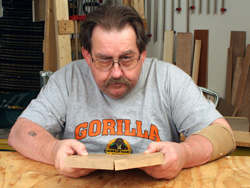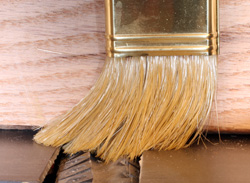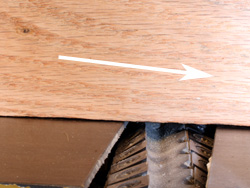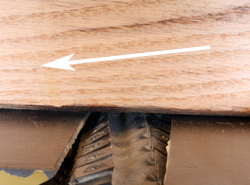This is a Veteran Owned site
 |
||||||||||||
Reading Grain OrientationProper feed direction is importantText, photos and video by by Tom Hintz Updated - 10-27-2011 The grain in wood is one of its most attractive features, but one that can also make it difficult to work with. If wood is machined in the wrong direction, the edges of grain lines can lift or separate, requiring additional sanding to achieve a smooth surface before finishing. In more severe cases, a cutter catching the edge of a grain line may contribute to kickout or even a fracture. Both situations can turn the piece into scrap, but more importantly, both can represent a danger to the woodworker. Wood grain actually consists of bundled fibers that can be up to 100 times longer than they are wide. These bundles are aligned along the trees vertical axis, but their path is never perfectly straight. While present everywhere in wood, the most visible grain is at the growth rings, developed annually as each seasons growth adds to the trees circumference. Because we can readily see growth rings, they are the landmarks we use to determine grain orientation in a piece of wood. Up, Down, With or AgainstThe first thing to understand is the terminology used to describe the meeting of cutter and grain. When the cutter is working down, or with the grain, the bundles are sliced cleanly, leaving a smooth surface with minimal defects. If the cutter is working up, or against the grain, the grain can snag or lift. The resulting surface could be rougher than anticipated and require considerable sanding to correct.
It is also important to remember that the portion of the cutter actually meeting the wood turns against the direction of feed. That is a constant with routers, jointers, planers, table saws and their hand-held equivalents. Though not as quickly, belt sanders can also raise grain edges, making orientation important in their use as well. While this story admittedly focuses on the interaction of power tools and wood grain, the same principles are equally important with similar hand tools. A sharp hand plane cannot cut as cleanly when working against the grain as it does when traveling in the proper direction. Reading the GrainReading grain direction correctly can be more difficult than you might suspect. Because boards are cut along the vertical axis of a tree, the angle of the grain within a board can be slight, but no less important. Grain usually runs from somewhere within (or through) a piece of wood to the surface. If that high point encounters the cutter first, the ends of the grain bundles can be snagged, or lifted. The result is often chipping or separated ends. With the ends of the grain angling away from the cutter, the ends are more likely to slice cleanly, leaving a smooth surface. When the angle of grain is relatively steep, determining direction is easy. However, when this angle is more subtle, or appears to run parallel to the long axis of a piece of wood, it can be difficult to identify the correct direction of feed.
To illustrate this interaction between grain and cutters, hold a common paint brush (see photos) at an angle, and then slide your hand across the bristles in both directions. Notice how easily the bristles slip over your hand when their ends are pointed in approximately the same direction your hand is moving. Then, notice how the bristles catch when their ends face the direction of your hand. Though exaggerated, this is essentially what happens when feeding wood through the various cutters we use in our shops. One way to help decipher subtle grain angles is to use a combination square. Pick out a prominent grain line near one end of the piece of wood and set the blade to that line. Then, slide the square along the wood to see if that grain line rises or falls along the length. Grain patterns on the face of boards can be deceiving. When growth rings are dissected during the sawing process, they can show a feathered-appearing edge that might appear to indicate the wrong feed direction. Looking at the edge of the board is often a better way to determine if the grain is rising or falling. Marking the grain direction noted on both sides of the wood can help prevent mistakes when sending it through a machine. Very often, opposing sides of a board must be fed in opposite directions to maintain proper grain orientation in relation to the cutter. Mystery GrainsOccasionally a piece of wood has grain that appears to run parallel to its length. In these cases, correct feed direction can be virtually impossible to determine visually, or with a combination square. In some situations, an educated guess, followed by close inspection of the freshly machined surface is the best you can do.
Often one feed direction produces a noticeably smoother surface than the other. Sometimes the difference can be very subtle. In the rare instances when feed direction shows no difference, watch the results produced in successive passes as grain orientation usually changes as wood is removed. Because Mother Nature, whom we can hold responsible for wood grain and it's random orientation, is not inclined to make things easier for woodworkers, we must learn the techniques necessary to obtain the best results from this ever-changing medium. The effort expended reading grain orientation in a piece of wood is more than offset by eliminating unnecessary steps in surface preparation, and the potential loss of the wood should it fracture. Many of the tasks in woodworking become second nature if we use them consistently when learning. Identifying grain orientation should be one of those "automatic" steps we all use in our shops. Reading grain is free, improves our projects and can help keep us safe. |
||||||||||||
Do you have a comment about this page? - Email Me!
|
||||||||||||
All written, photographic and drawn materials are property of and copyright by NewWoodworker.com LLC 2000-2019. Materials may not be used in any way without the written permission of the owner.





